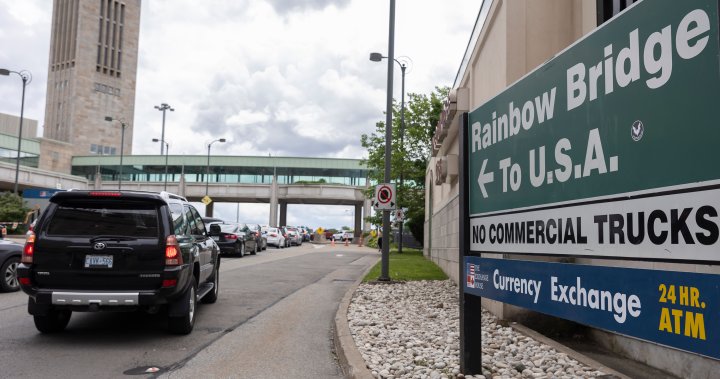Jobs
$900M project will create hydrogen plants, refuelling stations, up to 300 jobs: B.C. government | CBC News

The British Columbia government says a $900 million project to create a network of hydrogen production plants and vehicle refuelling stations will create nearly 300 jobs and cut greenhouse gas emissions in the province.
The Crown corporation Canada Infrastructure Bank (CIB) is providing a $337 million loan to support the project by hydrogen company HTEC, which involves plans to build up to 20 refuelling stations for hydrogen fuel-cell vehicles, 18 of them in B.C. and the others in Alberta.
The CIB and the B.C. government say the refuelling stations will be supplied by three new hydrogen production plants in Burnaby, Nanaimo and Prince George.
They say a facility to liquefy 15 tonnes of byproduct hydrogen will also be built in North Vancouver and the project, called H2 Gateway, will create more than 280 jobs.
The government says 14 of the new stations will be able to refuel up to 300 heavy vehicles per day. It says hydrogen fuel-cell vehicles can travel long distances and have short refuelling times.
Green hydrogen has been labelled as one solution for Canada to meet its net zero goal by 2050. CBC’s Frances Willick finds out if green hydrogen is really better for the environment.
Premier David Eby, who was attending the project announcement with federal Natural Resources Minister Jonathan Wilkinson and other officials, says H2 Gateway represents an economic and job-creation opportunity and a way to reduce pollution.
“We know the cost of inaction on climate change is not just in the price of responding to extreme weather like forest fires,” Eby said.
“Inaction would also cost us new jobs, new investment and new opportunities in growing a cleaner economy. We can’t afford to miss this economic opportunity. That’s why we’re supporting job-creating clean-energy hydrogen projects that will drive new investment and reduce pollution.”

The B.C. government says H2 Gateway could reduce emissions by about 133,000 tonnes a year.
“Producing clean fuels like hydrogen right here in B.C. to replace diesel use for transportation helps to reduce harmful pollution while creating new jobs and opportunities in the clean economy,” said Minister of Energy, Mines and Low Carbon Innovation Josie Osborne.
More than half of Canada’s hydrogen and fuel-cell companies are in B.C., the provincial government says.
HTEC president Colin Armstrong said developing an “ecosystem” of supply and fuelling stations was the first step in creating demand for hydrogen adoption in the transport industry.
“We can’t quite drive up to Prince George today, but our goal is to connect up there, particularly on the heavy-duty side of things,” Armstrong said. “But once we do this, we believe we can take [hydrogen] certainly across the country and to the rest of the world.”
The project is designed to support hydrogen fuel-cell vehicles that the government says can travel long distances and have short refuelling times, and 14 of the new stations will be able to refuel up to 300 heavy vehicles per day.
‘A potential clean-burning fuel for mass adoption’
Murray Thomson, professor of mechanical and industrial engineering at the University of Toronto, said hydrogen has long been championed as a potential clean-burning fuel for mass adoption because it emits only water when consumed while generating a large amount of energy.
That large quantity of energy generated through hydrogen and its refill speed are two reasons the trucking sector prefers the source to electric trucks weighed down by heavy batteries with low energy density.
“Trucks need a lot of energy,” Thomson said. “So you’d have to have a lot of batteries, and that might not be practical. Hydrogen is a way to [get] a lot of energy-dense fuel on trucks.”
WATCH | CBC News explains why 6 hydrogen-fuelled transport trucks will soon roll on B.C. roads:
Minister of Energy, Mines and Low Carbon Innovation Josie Osborne announced a pilot project that would see six heavy-duty fuel-cell trucks on the road by 2023, with the goal of replacing diesel-powered trucks to reduce emissions from the transportation sector.
He said, while he isn’t familiar with the details of the H2 Gateway, its plan on paper has several factors that could help it realize the decarbonization goal stated in the project’s announcement.
First, the hydrogen production would be through electrolysis, a process that doesn’t emit carbon, unlike the creation of hydrogen through processes such as natural gas reforming.
Second, the electricity needed for the hydrogen production plants in B.C. would be mostly from hydro, further limiting carbon emissions in the process.
Cost as a major hurdle in hydrogen adoption
Thomson said the key challenge for hydrogen adoption now is cost, and a decision for the federal government to financially support such a project is crucial in determining how a larger scale-up of the technology will look.
“Many times, you really don’t know how it’s all going to turn out,” he said. “You don’t know all the implications until you build it. So to a certain extent, building this first-of-a-kind technology — getting it out there, see how it works — is essential to see the potential of this technology.
“You can only do so much just designing it. You need to deploy it in order to really get the technology going.”
HTEC did not provide a timeline for construction of the H2 Gateway on its fact sheet for the project.











